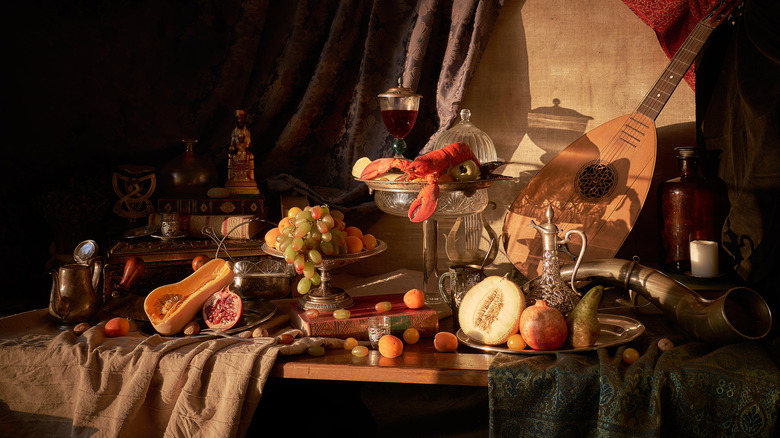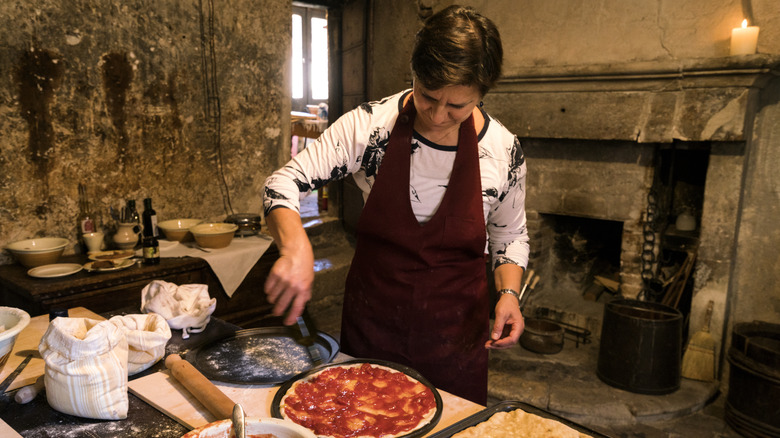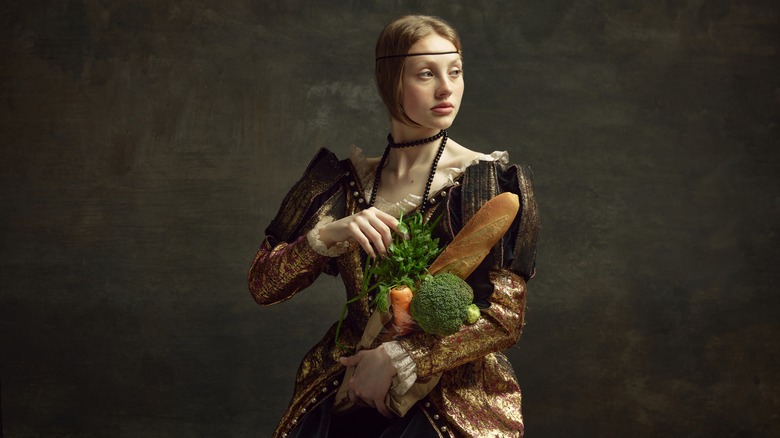In Medieval Times, Recipes Were Only For The Wealthy
Medieval times were characterized by the bubonic plague, the Crusades, the growing power of the Catholic church, and intense wealth disparity between classes (feudalism). But, for all its turbulence, this epoch (aka the Middle Ages or Dark Ages) set in motion what would evolve into the food scene as it's known today.
In the kitchens of the Middle Ages, food was a great (if perhaps the only) equalizer. Meals were enjoyed as a gathering event, and servants dined with their masters. Medieval cooks resided in the castles of their employers and, though servants, were revered members of society. Cooks had all their recipes memorized and passed down through oral tradition, which meant you wouldn't find a cookbook in most medieval households. In the 15th century, recording a recipe at all was a symbol of status in itself because a written recipe meant that you had enough wealth to afford parchment. As a result, all recipes that were recorded during these times came from the kitchens of the affluent.
Being able to write a recipe also implies literacy, and during the Middle Ages it was unusual for children who were not destined for aristocracy or clergy to receive an education at all until around the 11th century. Only a highly educated person could have recorded a recipe on paper.
Cooking was a labor of love, and so was writing
The printing press wouldn't be invented until the 15th century, meaning that all written recipes had to be recorded by hand, and anything deemed important enough to be recorded during the Middle Ages was usually decorated with ornate designs and artistic lettering befitting of the significance. Oral tradition also carried a sentimental aspect, as the verbal passing down of generational recipes was often an act of cultivating family history.
The few surviving recipes from the Middle Ages were written in Middle English (which will look familiar to anyone who has read "The Canterbury Tales"), and they clue historians in to what dishes were on the tables of the medieval elite. For instance, "The Medieval Cookbook" by Maggie Black shares a recipe for cabbage chowder that instructs, "Take caboches and quarter hem, and seeth hem in gode broth with oynouns ymynced and the whyte of lekes yslyt and ycorue smale." Another recipe for lamb or mutton stew reads, "'Take veel other[wise] motoun and smyte it to gobettes."
During this era, the Catholic church forbade eating meat (except for fish, which was widely accessible) for roughly one-third of the year. This heavily restricted diet and bred the creation of some innovative pescatarian dishes, like creamed fish and haddock in ale sauce. Common folk ate cabbage, carrots, onions, and leeks, often boiled or stewed. Pickled mixed vegetables, rose pudding, and other dishes were popular, and cooks made them with whatever they had on hand.
Common folk had no use for recipes; they cooked with whatever was available
Dishes in the Middle Ages ranged widely from subsistence meals to extravagant feasts. For the nobility, food was a symbol of wealth and a way to impress your other rich friends. For the working class, food wasn't so much an art as a thing you ate to avoid dying. Still, across the board, the medieval diet was affected by seasons, regionality, and religion. Even for the nobility, folks ate what was local; mutton, goose, duck, robin, swan, rabbit, and squirrel were fair game (pun intended).
Poorer cooks had access to fewer ingredients, making for a blander diet. While common folks could fish, they couldn't hunt the wild boar or deer that romped in forests owned by nobility — and they couldn't eat their chickens, because they relied on the eggs. Working class fare was mostly cereals made from barley, oats, and rye, while wheat was set aside for folks in the wealthier echelons.
Meat and dairy products from cows were dietary staples for serfs and nobility alike, but richer households got better cuts, with the poorer households buying less desirable portions that took longer to cook. This ended up not being such a bad deal in a roundabout way. In the Middle Ages, spices (which were only available to the wealthy) were used to mask the taste of spoiled meat. Since poor folks had to cook their cuts of meat longer, they often inadvertently cooked off harmful bacteria.


